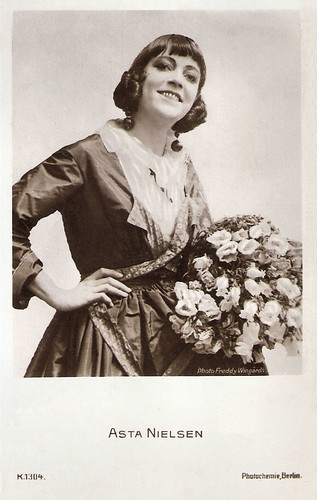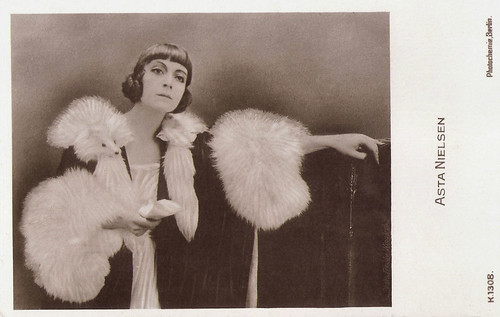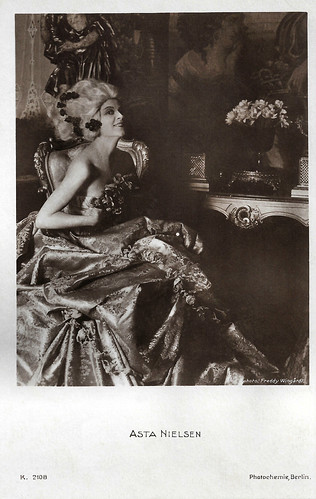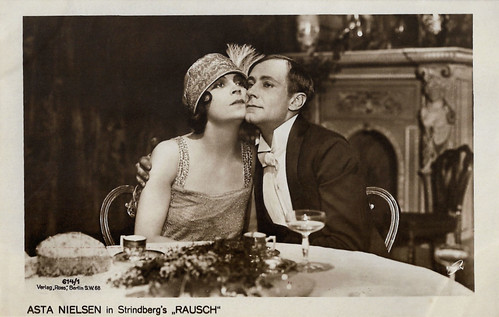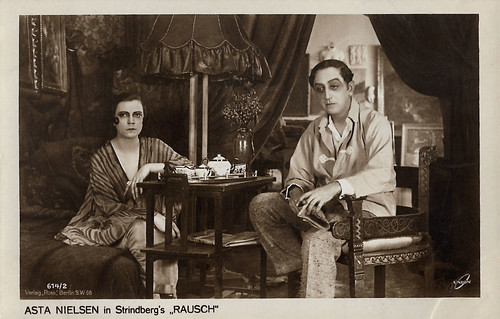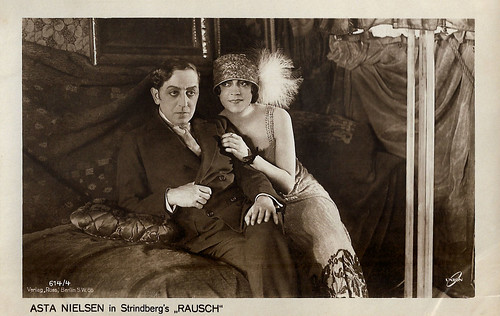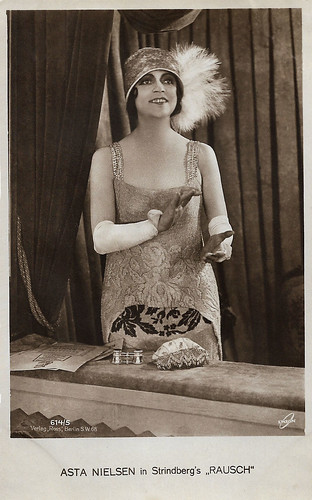
German postcard by Verlag Herm. Leiser, Berlin-Wilm., no. 3047.

German postcard by Photochemie, Berlin, no. K. 2769. Photo: Freddy Wingardh. Asta Nielsen in the stage pantomime 'Der verlorene Sohn' (The Lost Son, 1918). Collection: Marlene Pilaete.
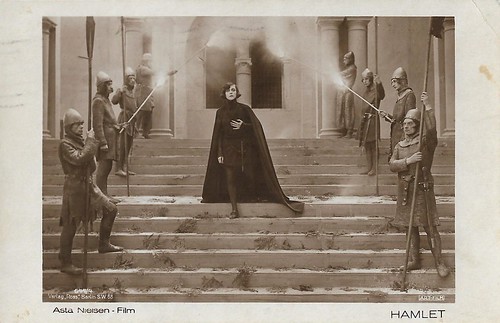
German postcard by Verlag Ross, Berlin, no. 644/4, 1919-1924. Photo: Art-Film / Asta Nielsen-Film. Asta Nielsen as Hamlet in Hamlet (Svend Gade, Heinz Schall, 1921). Asta Nielsen had produced the film herself.

French postcard by Cinémagazine-Edition, Paris, no. 200. Photo: Asta Nielsen in Hedda Gabler (Franz Eckstein, 1925).

German postcard by Ross Verlag, no. 1020/1, 1927-1928. Photo: Oertel, Berlin. Asta Nielsen in Die freudlose gasse/The Joyless Street (G.W. Pabst, 1925). Dutch artist Pyke Koch used photos like the one on this card for his portrait of Asta Nielsen (1929).
Unique Physical Attraction
Asta Sofie Amalie Nielsen was born in the Copenhagen suburb of Vesterbro, Denmark, in 1881. She was the daughter of an often unemployed blacksmith and a washerwoman. Nielsen's family moved several times during her childhood while her father sought employment.
When she was fourteen years old, her father died. Asta's stage debut came as a child in the chorus of the Kongelige Teater's production of Arrigo Boito's opera 'Mephistophele'. At the age of eighteen, Nielsen was accepted into the drama school of the Royal Danish Theatre. During her time there, she studied with the Royal Danish actor Peter Jerndorff.
In 1901, twenty years old, she became pregnant and gave birth to her daughter, Jesta. She refused to marry the child’s father, a law student because marriage would have inhibited her theatrical ambitions. It was a fairly audacious decision for a working-class girl in 1901, but Nielsen was single-minded in matters of love and work. Nielsen never revealed the identity of the father and chose to raise her child alone with the help of her mother and older sister.
In 1902 she graduated from drama school. For the next three years, she worked at the Dagmar Theatre, then toured in Norway and Sweden from 1905 to 1907 with De Otte and the Peter Fjelstrup companies. Returning to Denmark, she was employed at Det Ny Theater (The New Theatre) from 1907 to 1910.
Although she worked steadily as a stage actress, her performances remained unremarkable. Danish historian Robert Neiiedam wrote that Nielsen's unique physical attraction, which was of great value on the screen, was limited on stage by her deep and uneven speaking voice.

German postcard. Photo: Asta Nielsen and Hugo Flink in Die Kinder des Generals/The General's Children (Urban Gad, 1912).

German postcard. Asta Nielsen and Hans Mierendorff in Jugend und Tollheit/Lady Madcap's Way (Urban Gad, 1913).

German postcard by Photochemie, Berlin, no. K. 1307. Photo: Asta Nielsen Atelier.

German postcard by Photochemie, Berlin, no. K. 1309. Photo: Freddy Wingärdh. Asta Nielsen in Das Liebes-ABC (Magnus Stifter, 1916).

German postcard by Photochemie, Berlin, no. K. 1312. Photo: Freddy Wingardh. Asta Nielsen in Dora Brandes (Magnus Stifter, 1916).
Scandalous eroticism and a uniquely minimalist acting style
In 1909, set designer and director Urban Gad encouraged Asta Nielsen to become a film actress and she starred in his Danish silent film Afgrunden/The Abyss (Urban Gad. 1910). Gary Morris observes in Bright Lights Film Journal: "this film established from the beginning key components of her legend: scandalous eroticism and a uniquely minimalist acting style."
Asta plays a music teacher lured away from her stolid fiancee (Robert Dinesen) by a sexy but faithless circus cowboy (Poul Reumert). In a startling sequence of sexual intensity, she lassos her boyfriend and does a lewd dance, bumping and grinding against him. Morris: "This vulgar ‘gaucho-dance’ was what most viewers remembered, but critics of the time also applauded Asta's naturalistic acting."
The film was a huge success so she was encouraged to continue. The following year Balletdanserinden/The Ballet Dancer (August Blom, 1911) proved to be another success. Nielsen and Gad soon married.
A German distributor, Paul Davidson, invited Nielsen to Germany, where he was building a new studio. Eventually, this would become Europe's largest film studio - the Universum Film Union A.-G. (or Ufa). Asta signed a contract for $80,000 a year, then the highest salary for a film actress. In 1911, she moved to Berlin with Urban Gad.
In a Russian popularity poll of that year, she was voted 'world's top female film star', behind French comedian Max Linder and ahead of her Danish compatriot Valdemar Psilander.

German postcard by Photochemie, Berlin, no. K. 1313. Photo: Freddy Wingardh. Asta Nielsen in her outfit from Das Versuchskaninchen/The guinea pig (Edmund Edel, 1916).

German postcard by Photochemie, Berlin, no. K. 1422. Photo: Neutral-Film. Asta Nielsen in Das Eskimo-Baby/The Eskimo Baby (Walter Schmidthaessler, 1916-1918).

German postcard by Photochemie, Berlin, no. K. 1423. Photo: Neutral Film. Asta Nielsen and Freddy Wingardh in their outfits from Das Eskimobaby (Walter Schmidthässler, 1916-1918).

German postcard by Verl. Hermann Leiser, Berlin-Wilm., no. 7282. Asta Nielsen in Die weissen Rosen/The white roses (Urban Gad, 1916).
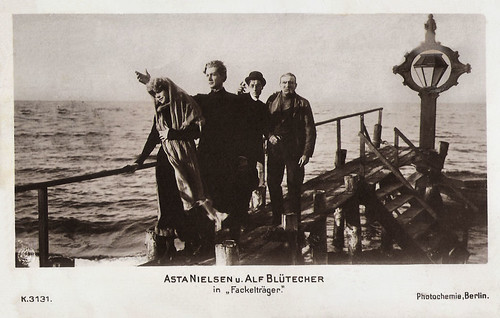
German postcard by Photochemie, Berlin, no. K. 3131. Photo: Nordisk. Asta Nielsen and Alf Blütecher in Mod lyset/Fackelträger/Towards the Light (Holger-Madsen, 1919).
The drunkard's vision and the lonely man's dream
In the next six years, Asta Nielsen played every conceivable kind of character in both tragedies and comedies. In Die Suffragette/The Militant Suffragette (Urban Gad, 1913), she is an English female liberationist whose beliefs force her to become violent, placing a bomb in Parliament.
In Zapatas Bande/Zapata's Gang (Urban Gad, 1916), she plays a highway robber. In the comedy Das Liebes-ABC/The ABCs of Love (Magnus Stifter, 1916), she pretends to be a man and takes her wimpy boyfriend out on the town in order to "bring out the man in him."
Nielsen was so famous that the name Asta became a trademark for cigarettes and perfumes. In the Dutch city The Hague, a cinema was named after her. Her beauty was praised by the poet Guillaume Apollinaire as "the drunkard's vision and the lonely man's dream". Belgian Paul van Ostaijen included the expressionistic poem 'Asta Nielsen', a paean to Nielsen's sensuousness, in his 1921 collection 'Bezette Stad' (Occupied City).
One of Asta's most interesting productions was Hamlet (Sven Gade, Heinz Schall, 1921). Gary Morris: "Asta brings a subtle twist to her version not by playing a man, but by playing a woman disguised as a man, adding another level of gender complexity. Hamlet was based less on William Shakespeare than on a popular book of the time that said Hamlet was actually a girl forcibly raised as a boy in order to provide an heir to the Danish throne. At first, the effect is more puzzling than effective, but the actress's strategy becomes evident in sexually charged scenes between Asta/Hamlet and Horatio, who caress and coddle each other in what surely appeared to viewers of the time (as it does to modern audiences) as a gay tryst.
Asta brilliantly imparts the gender-unstable nature of the character in these scenes with Horatio and others with Fortinbras, whose encounters with Hamlet are also clearly coded as gay. The actress's effortless creation of these subtle, sympathetic homosexual tableaux gives a tremendous vitality to this production. The fact that the film was truly hers — being the first film she made with her own production company — shows just how daring and modern she was."

German postcard by Ross Verlag, Berlin, no. 644/3, 1919-1924. Photo: Art-Films. Asta Nielsen as Hamlet in Hamlet (Svend Gade, Heinz Schall, 1921). Asta Nielsen had produced the film herself.

German postcard by Ross Verlag, no. 485/1, 1919-1924. Asta Nielsen in Fräulein Julie/Miss Julie (Felix Basch, 1922), after the play 'Fröken Julie' by August Strindberg.

German postcard by Ross Verlag, no. 580/5, 1919-1924. Photo: Art FilmAsta Nielsen as operetta diva Kaja Falk and Albert Bozenhard as her husband Frank Lorris in Der Absturz/Downfall (Ludwig Wolff, 1923). The Danish release title was Afgrunden, just like Nielsen's first film.

German postcard by Ross Verlag, no. 614/1. Photo: Union. Asta Nielsen and Alfred Abel in Rausch/Intoxication (Ernst Lubitsch, 1919).

German postcard by Ross Verlag, Berlin, no. 667/4. Photo: Neumann. Asta Nielsen as Mary Magdalen and Henny Porten as the Virgin Mary in the Biblical film I.N.R.I. (Robert Wiene, 1923).

Italian postcard by Ed. G. Vettori, Bologna, no. 342. Photo: Nero-Film. Asta Nielsen and Carl Auen in Das Haus am Meer/The house by the sea (Fritz Kaufmann, 1924).
Die Freudlose Gasse
Nowadays Asta Nielsen is best known for the classic Die Freudlose Gasse/The Joyless Street (G.W. Pabst, 1925). Asta plays in this film an impoverished woman who resorts to prostitution and murder.
In the original prints, there were two equal-time female leads: Nielsen and a young actress from Sweden, Greta Garbo. Ruthlessly cut for American release, the film suddenly became a Garbo vehicle. Fortunately, the print has been restored recently and Asta triumphs in it as the increasingly unbalanced Marie.
Nielsen continued to be a screen legend in Germany and appeared in films like Dirnentragödie/Tragedy of the Street (Bruno Rahn, 1927) and in her only sound film Unmögliche Liebe/Crown of Thorns (Erich Waschneck, 1932).
After the Nazis came to power she was rumoured to be offered her own studio by propaganda minister Joseph Goebbels. Understanding the implications well, she left Germany for good in 1936, settling in Denmark where she returned to stage acting and became a private figure.
During the Second World War, she provided money for Allan O. Hagedorff, a young Dane living in Germany, to assist Jews. Using money provided by Nielsen, Hagedorff sent so many food parcels to the Theresienstadt Ghetto that he was warned by the Gestapo. Among others, Victor Klemperer, the diarist and philologist, was offered money by Hagedorff.
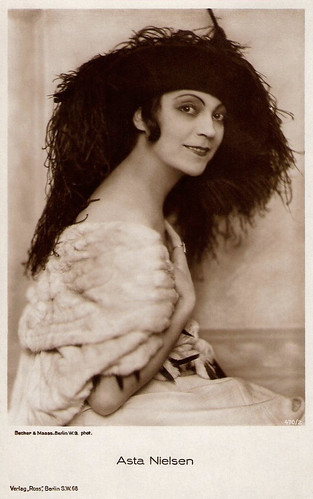
German postcard by Ross Verlag, no. 470/2, 1919-1924. Photo: Becker & Maass, Berlin.

German postcard by Ross Verlag, no. 580/3, 1919-1924. Photo: Art Film. Asta Nielsen and Gregori Chmara in Der Absturz/Downfall (Ludwig Wolff, 1923).

German postcard by Ross Verlag, no. 1006/1, 1927-1928. Photo: Stein. Asta Nielsen in Hedda Gabler (Franz Eckstein, 1925).

German postcard by Ross Verlag, no. 1140/1, 1927-1928. Photo: Alex Binder, Berlin. Asta Nielsen in Erdgeist/Earth Spirit (Leopold Jesner, 1923).

German postcard by Ross Verlag, no. 1140/2, 1927-1928. Photo: Alex Binder, Berlin.

German postcard by Ross Verlag, no. 3084/1, 1928-1929. Photo: Atelier Wulson, Berlin.
A director at 86
In her later years, Asta Nielsen wrote articles on art and politics and a two-volume autobiography, 'Den tiende Muse' (The Silent Muse) in 1946. She also became an acclaimed collage artist.
In 1964, Nielsen had to come to terms with the most severe blow of her life: her daughter Jesta committed suicide following the death of her husband.
At 86, Asta directed her first film. Luise F. Pusch writes in FemBio: "After a film about her life did not meet with her approval, she set to work on the project herself. The result was a work of art."
Nielsen had four long-term relationships and was divorced twice. In 1912, she married the Danish film director Urban Gad following their move together to Germany in 1911 to build their own film studio. They were divorced by 1919 when Nielsen married the Swedish shipbuilder Freddy Windgårdh. This marriage was short-lived and ended in divorce in the mid-1920s.
Nielsen fell in love with the Russian actor Gregori Chmara whom she met through their mutual friend Georg Brandes. They began a long-term common-law marriage that lasted from 1923 until the late 1930s.
In the late 1960s, Nielsen began a relationship with Danish art collector, Christian Theede, whom she had met through dealings of her own artwork. In 1970, at the age of 88-years-old, Nielsen married the 77-year-old Theede. the great love of her life. Nielsen and Theede's happiness at marrying at an advanced age was celebrated in the world press. The two enjoyed their travels together so much that they decided to leave their fortune to a foundation to fund trips for the elderly.
In 1972, Asta Nielsen died at Frederiksberg Hospital in Copenhagen after a leg fracture. She was 90.

German postcard by Ross Verlag, Berlin, no. 379/3, 1919-1924. Photo: Becker & Maass.

German postcard by Ross Verlag, Berlin, no. 379/4, 1919-1924. Photo: Becker & Maass phot.

German postcard by Ross Verlag, Berlin, no. 380/3, 1919-1924. Photo: Becker & Maass.

German postcard by Ross Verlag, Berlin, no. 380/4, 1919-1924. Photo: Becker & Maass.

German postcard by Ross Verlag, no. 406/3, 1919-1924. Photo: Becker & Maass.

German postcard by Ross Verlag, Berlin, no. 406/4. 1919-1924. Photo: Becker & Maass, Berlin.

German postcard by Ross Verlag, Berlin, no. 3522/1, 1928-1929. Photo: Atelier Mahrenholz.

German postcard by Verl. Hermann Leiser, Berlin-Wilm, no. 3009.

German postcard by Verlag Hermann Leiser, Berlin-Wilmersdorf, no. 8643. Photo: Willinger. Caption: Asta Nielsen at home. Nielsen wears the dress and hat from her film Die falsche Asta Nielsen/The false Asta Nielsen (Urban Gad, 1915).
More, more, more Asta!
Importing Asta Nielsen Database (IANDb) stores all available data on the global distribution and exhibition of the 27 long feature films starring Asta Nielsen that were released before the First World War.
In 2016, EFSP contributor Ivo Blom wrote in the journal Nineteenth Century Theater and Film a review of the volume 'Importing Asta Nielsen: The International Film Star in the Making 1910–1914' (2013), edited by Martin Loiperdinger and Uli Jung.
The Kunstmuseum Brandts in Odense had a large exhibition on Asta Nielsen in 2020-2021, entitled 'The Asta: The Silent Superstar of Silent Film'.
Several Danish and German silent films with Asta Nielsen can be viewed for free and in pristine prints on a special section of the site of the Danish Film Institute. See on the same site the article 'Asta Nielsen – #Bosslady', a feminist interpretation by Nanna Frank Rasmusse nof Nielsen.
In 1999 the Kinothek Asta Nielsen was founded in Frankfurt am Main, Germany. This organisation documents and gives access to the film works by women in the past and the present. In 2009 Heide Schlüpmann, Karola Gramann and others published e.g. a two-volume publication on Asta Nielsen, made by Kinothek Asta Nielsen and Filmarchiv Austria.
Several DVDs with films with Nielsen have been released by Edition Filmmuseum, while in 2020 Barbara Beuys published the latest biography, 'Asta Nielsen: Filmgenie und neue Frau'.
Afgrunden/The Abyss (1910). Source: The First Movies (YouTube).
Sources: Gary Morris (Bright Lights Film Journal), Pamela Hutchinson (The Guardian), Luise F. Pusch (FemBio), Jim Beaver (IMDb), Wikipedia, and IMDb.

